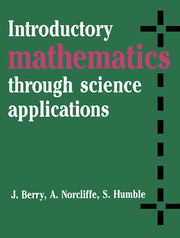Book contents
- Frontmatter
- Contents
- Preface
- 1 Basic functions
- 2 Functions for science 1: the exponential function
- 3 Functions for science 2: trigonometric functions
- 4 Functions for science 3: inverse functions
- 5 Other functions of science
- 6 Differentiation 1: rates of change
- 7 Differentiation 2: stationary points
- 8 Differentiation 3: approximation of functions
- 9 Integration 1: introduction and standard forms
- 10 Integration 2: techniques of integration
- 11 Integration 3: further techniques
- 12 First-order ordinary differential equations
- 13 Second-order ordinary differential equations
- 14 Statistics 1: frequency distributions and associated measures
- 15 Statistics 2: probability and probability distributions
- 16 Statistics 3: sampling, sampling distributions and hypothesis testing
- 17 Partial differentiation 1: introduction
- 18 Partial differentiation 2: stationary points
- Answers to the exercises
- Index
15 - Statistics 2: probability and probability distributions
Published online by Cambridge University Press: 05 June 2012
- Frontmatter
- Contents
- Preface
- 1 Basic functions
- 2 Functions for science 1: the exponential function
- 3 Functions for science 2: trigonometric functions
- 4 Functions for science 3: inverse functions
- 5 Other functions of science
- 6 Differentiation 1: rates of change
- 7 Differentiation 2: stationary points
- 8 Differentiation 3: approximation of functions
- 9 Integration 1: introduction and standard forms
- 10 Integration 2: techniques of integration
- 11 Integration 3: further techniques
- 12 First-order ordinary differential equations
- 13 Second-order ordinary differential equations
- 14 Statistics 1: frequency distributions and associated measures
- 15 Statistics 2: probability and probability distributions
- 16 Statistics 3: sampling, sampling distributions and hypothesis testing
- 17 Partial differentiation 1: introduction
- 18 Partial differentiation 2: stationary points
- Answers to the exercises
- Index
Summary
In the last chapter we saw how experimental data could be organised and how measures of centre and scatter could be worked out to give a collective description of the data. This description was useful because it helped tell us what to expect from future experiments. However, when making predictions about future experiments, we have to bear in mind that the predictions we make are going to be based on only a sample of results and will necessarily have a measure of uncertainty associated with them. Being able to express numerically the inevitable uncertainties in the results of statistical analyses is very important in science, but it requires first of all an understanding of probability and of probability distributions. In this chapter we cover the basics of probability and consider some of the theoretical probability distributions that are important in handling scientific data.
Scientific context
Example 1: radiation decay data revisited. To provide us with some data for discussing the basic ideas of probability, let us return to the radiation decay data that we considered in Chapter 14. For convenience we present the 500 data values again in Table 15.1. Suppose we want to know what the chances are of observing fewer than 4 counts in another 10-s exposure of the geiger counter to the radioactive source. Since the words ‘chance’ and ‘probability’ mean the same thing, then what we are really wanting to work out here is nothing more than a probability – the probability of observing fewer than 4 counts.
- Type
- Chapter
- Information
- Introductory Mathematics through Science Applications , pp. 395 - 429Publisher: Cambridge University PressPrint publication year: 1989



